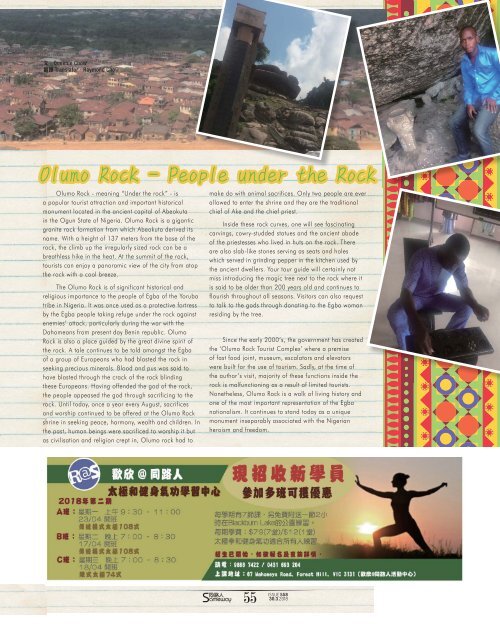Issue 558
Create successful ePaper yourself
Turn your PDF publications into a flip-book with our unique Google optimized e-Paper software.
Queenie Chow<br />
TranslatorRaymond Chow<br />
<br />
Olumo Rock - meaning “Under the rock” - is<br />
a popular tourist attraction and important historical<br />
monument located in the ancient capital of Abeokuta<br />
in the Ogun State of Nigeria. Olumo Rock is a gigantic<br />
granite rock formation from which Abeokuta derived its<br />
name. With a height of 137 meters from the base of the<br />
rock, the climb up the irregularly sized rock can be a<br />
breathless hike in the heat. At the summit of the rock,<br />
tourists can enjoy a panoramic view of the city from atop<br />
the rock with a cool breeze.<br />
The Olumo Rock is of significant historical and<br />
religious importance to the people of Egba of the Yoruba<br />
tribe in Nigeria. It was once used as a protective fortress<br />
by the Egba people taking refuge under the rock against<br />
enemies’ attack, particularly during the war with the<br />
Dahomeans from present day Benin republic. Olumo<br />
Rock is also a place guided by the great divine spirit of<br />
the rock. A tale continues to be told amongst the Egba<br />
of a group of Europeans who had blasted the rock in<br />
seeking precious minerals. Blood and pus was said to<br />
have blasted through the crack of the rock blinding<br />
these Europeans. Having offended the god of the rock,<br />
the people appeased the god through sacrificing to the<br />
rock. Until today, once a year every August, sacrifices<br />
and worship continued to be offered at the Olumo Rock<br />
shrine in seeking peace, harmony, wealth and children. In<br />
the past, human beings were sacrificed to worship it but<br />
as civilisation and religion crept in, Olumo rock had to<br />
make do with animal sacrifices. Only two people are ever<br />
allowed to enter the shrine and they are the traditional<br />
chief of Ake and the chief priest.<br />
Inside these rock curves, one will see fascinating<br />
carvings, cowry-studded statues and the ancient abode<br />
of the priestesses who lived in huts on the rock. There<br />
are also slab-like stones serving as seats and holes<br />
which served in grinding pepper in the kitchen used by<br />
the ancient dwellers. Your tour guide will certainly not<br />
miss introducing the magic tree next to the rock where it<br />
is said to be older than 200 years old and continues to<br />
flourish throughout all seasons. Visitors can also request<br />
to talk to the gods through donating to the Egba woman<br />
residing by the tree.<br />
Since the early 2000’s, the government has created<br />
the ‘Olumo Rock Tourist Complex’ where a premise<br />
of fast food joint, museum, escalators and elevators<br />
were built for the use of tourism. Sadly, at the time of<br />
the author’s visit, majority of these functions inside the<br />
rock is malfunctioning as a result of limited tourists.<br />
Nonetheless, Olumo Rock is a walk of living history and<br />
one of the most important representation of the Egba<br />
nationalism. It continues to stand today as a unique<br />
monument inseparably associated with the Nigerian<br />
heroism and freedom.<br />
55<br />
ISSUE <strong>558</strong><br />
30.3.2018













